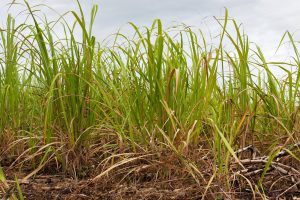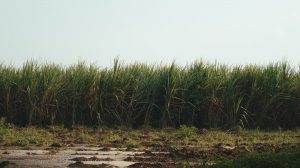Sugar, one of the most consumed foods in the world is produced by the sugarcane plant. Sugarcane has the characteristic sweetness of fruits but doesn’t look like one. It doesn’t fit in with other vegetables either; this has led to the confusion of many regarding its classification.
In this article, we answer the question “Is sugarcane a fruit or a vegetable?” (hint: neither, it’s a grass!) and discuss other interesting information about this wonderful plant. Read on to find out more.

Scientific Classification of Sugarcane
- Kingdom: Plantae
- Sub-kingdom: Tracheobionta
- Super-division: Spermatophyta
- Division (Phylum): Magnoliophyta
- Class: Liliopsida
- Subclass: Commelinidae
- Order: Poales
- Family: Poaceae
- Genus: Saccharum L.
- Species: Saccharum officinarum
What is Sugarcane?
Saccharum officinarum or sugarcane is a tall perennial tropical grass with lateral shoots at its base leading to the growth of multiple stems. These stems can grow up to 3-4 meters (10-13 feet) in height with a diameter of 5 centimeters (about 2 inches). The plant is grown and harvested as a cash crop for these stems from which sugar is produced.
The sugarcane plant was first domesticated in New Guinea by Papuans, who selectively bred the plant from the native parent plant Saccharum robustum. However, they only used it as fodder for domestic animals like pigs. The modern cultivation of sugarcane to primarily produce sugar originated in northern India. The sugarcane plant travelled to the West through colonial trade routes.
Could Sugarcane be a Fruit?
To answer this question, let’s look at the definition of a fruit.
What is a Fruit?
Botanically speaking, a fruit is the mature ovary of a flowering plant and contains seeds within it. In fact, several plant products which are culinarily considered vegetables are actually fruits; this includes gourds, tomato, chilli peppers, capsicum, raw banana, and corn.
Reproductive System of Sugarcane
Sexual reproduction in sugarcane occurs through its seeds and flowers. Sugarcane flowers are typically unisexual, meaning that individual plants produce either male (staminate) or female (pistillate) flowers and are rarely hermaphrodite.
Although sugarcane is capable of sexual reproduction, the occurence of natural pollination in sugarcane plants is rare as they are usually propagated by farmers through vegetative reproduction using stem cuttings (seed cane or cane sets).
Is Sugarcane a Fruit?
With the above definition of a fruit, we can conclude that sugarcane is not a fruit as it is a stem which does not develop from the fertilized flowers of a flowering plant and contain seeds with it.
Also Read: Top 10 Delicious Florida Fruits You Must Try.
Could Sugarcane be a Vegetable?

First, let’s discuss the culinary definition of a vegetable.
What is a Vegetable?
The term “vegetable” is not a botanical one, in that, there is not part of a plant which is called a vegetable in botany. The term is instead a culinary one, wherein any non-reproductive part of a plant which is used for culinary purposes is called a vegetable. This includes flowers (cauliflower), fruits (avocado), stems (celery), leaves (spinach), roots (carrots), and seeds (beans and peas).
Culinary Uses of Sugarcane
Sugarcane may be primarily used to extract sugar, but its culinary uses do not end there. Sugarcane stems are a food staple in countries where they are cultivated. They are used in sweeteners like jaggery, alcoholic drinks like cachaça, and even cooked dishes like lemon chicken with sugarcane juice.
Is Sugarcane a Vegetable?
The answer to this question is a bit tricky. Going by the definition of a vegetable, it technically makes sense that sugarcane falls into the category. However, sugarcane is not a vegetable as it is primarily used as a sweetener and not cooked into dishes.
Unlike other vegetables, sugarcane is not primarily used for culinary purposes. It is an addition, yes. However, it is often just used raw or as a sweetener to add flavour. To put this in perspective, consider rosemary sprigs; they are herbs and not vegetables despite there being other leafy produce which are considered vegetables as they are only added for extra flavour.
Could Sugarcane be a Grass?
To explore this question thoroughly, let’s look into the definition of grass.
What is a Grass?
Grass can be defined as any of the green, non-woody plants belonging to the grass family (Poaceae), the sedge family (Cyperaceae), and the rush family (Juncaceae). Grasses have a wide range of uses. Depending on their type, they are used as cereal grains, forage and pasture grasses, ornamental grasses, wetland and marsh grasses to name a few.
Is Sugarcane a Grass?
Yes, sugarcane is a type of grass which belongs to the grass family (Poaceae). Although it doesn’t have the conventional appearance of grass, sugarcane carries many of the typical characteristics of grass including long, narrow leaves with parallel veins and jointed stems. Additionally, like other grasses, sugarcane exhibits a tufted growth habit with new stems emerging from the bottom of the plant.
Also Read: Red Vs White Dragon Fruit.
Sugarcane as an Edible Plant

You would be surprised to know that sugarcane is an important ingredient in most South Asian, African and South American cuisines. For instance, sugarcane holds cultural significance in the celebration of harvest festivals in southern India. Here are some of the methods in which sugarcane is used to make food and drinks:
- Raw sugarcane: A common way to enjoy sugarcane is to have it as a snack. The stems are peeled, cut into bite-sized pieces and chewed thoroughly to extract the juice.
- Sugarcane juice: Also known as air tebu, usacha rass, guarab, guarapa, guarapo, papelón, aseer asab, ganna sharbat, mosto, caldo de cana, or nước mía, this cool, refreshing drink is made by extracting juice by hand or small mills and mixing it with some lemon juice and ice.
- Sayur nganten: An Indonesian soup made from the trubuk (Saccharum edule) variety of sugarcane.
- Rum: This may come as a surprise but rum is made by fermenting and then distilling sugarcane juice or sugarcane molasses. The distillate is then aged in oak barrels.
- Basi: Basi is an alcoholic beverage or wine made from fermented sugarcane juice in the Philippines and Guyana.
Sugarcane is also used to produce products like:
- Molasses: Used to sweeten and flavour foods, it is also used as a side syrup for foods like cheese and cookies.
- Jaggery: Traditionally consumed in the Indian subcontinent, Southeast Asia and Africa, jaggery is solidified molasses which is used in making sweets and desserts.
- Panela: Also known as radapura, these are solid pieces of sucrose and fructose created from boiling and evaporating sugarcane juice. Panela is a food staple in the Caribbean and Latin American countries including Colombia, Argentina, Brazil and Venezuela.
Nutritional Value and Health Benefits of Sugarcane
Sugarcane is an excellent source of carbohydrates and also contains essential vitamins and minerals such as vitamin C, vitamin B, calcium, iron, magnesium, and potassium.
Sugarcane juice is packed with powerful antioxidants like flavonoids, phenolic acids, and anthocyanins which have proven anti-inflammatory and anti-cancer properties, and help improve hair, skin, and nail health.
Non-Edible Uses of Sugarcane
Apart from having a diverse range of uses for culinary purposes, sugarcane also produces myriad byproducts, some of which are listed below:
- Sustainable alternative: After the juice has been extracted from the canes, a fibrous substance is leftover; this substance is called bagese. Bagese fibers can be used to produce environmentally sustainable products like paper, packaging materials and even biodegradable containers and kitchenware.
- Biofuel Production: Sugarcane can be used to produce biofuels like ethanol and bio-diesel. Ethanol is extracted from sugarcane by fermentation and is added as a renewable fuel additive to petroleum products.
- Renewable Energy Production: The leftover bagese can be burned to produce heat and electricity. Sugarcane mills often use bagese to power their operations and equipment.
- Construction Materials: Building equipment like boards, panels and planks can be made using bagese fibers with other materials, thus offering a sustainable alternative to conventional building materials.
- Animal Fodder: The tops and leaves of sugarcane are usually used as animal feed for livestock.
- Handicrafts and Artisanal Products: In some cultures, it is a traditional practice to use sugarcane fibers to create handmade products like baskets, mats. Sugarcane fibers are also used to construct fences and roof thatching.
Check out our recent article on ‘How to prevent fruit and vegetable wastage‘.
Conclusion
To wrap things up, we now know that sugarcane is neither a fruit nor a vegetable; it is a perennial tall grass which is cultivated for its stem from which juice is extracted and crystallized to produce sugar. In addition to sugar, sugarcane also produces other products and benefits which are listed above.
























